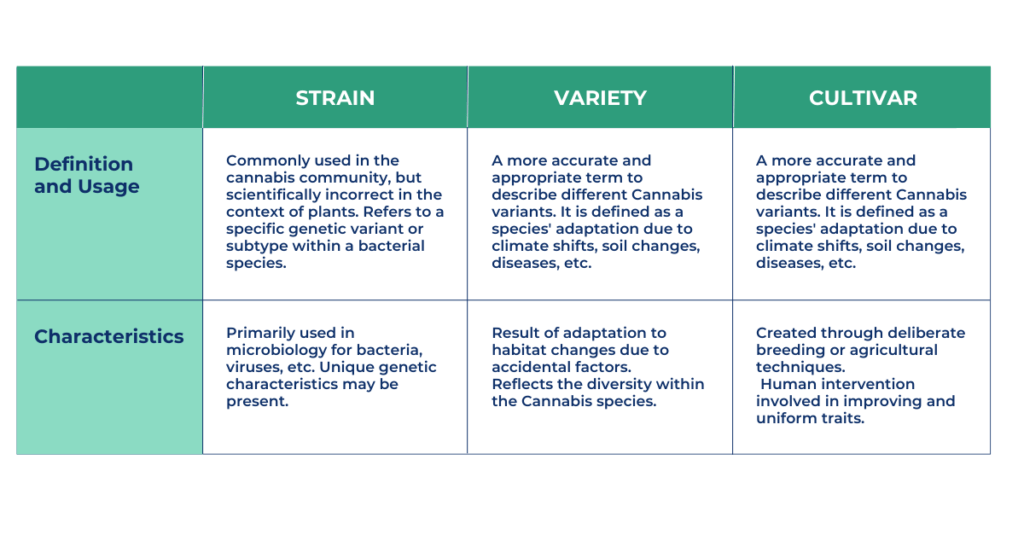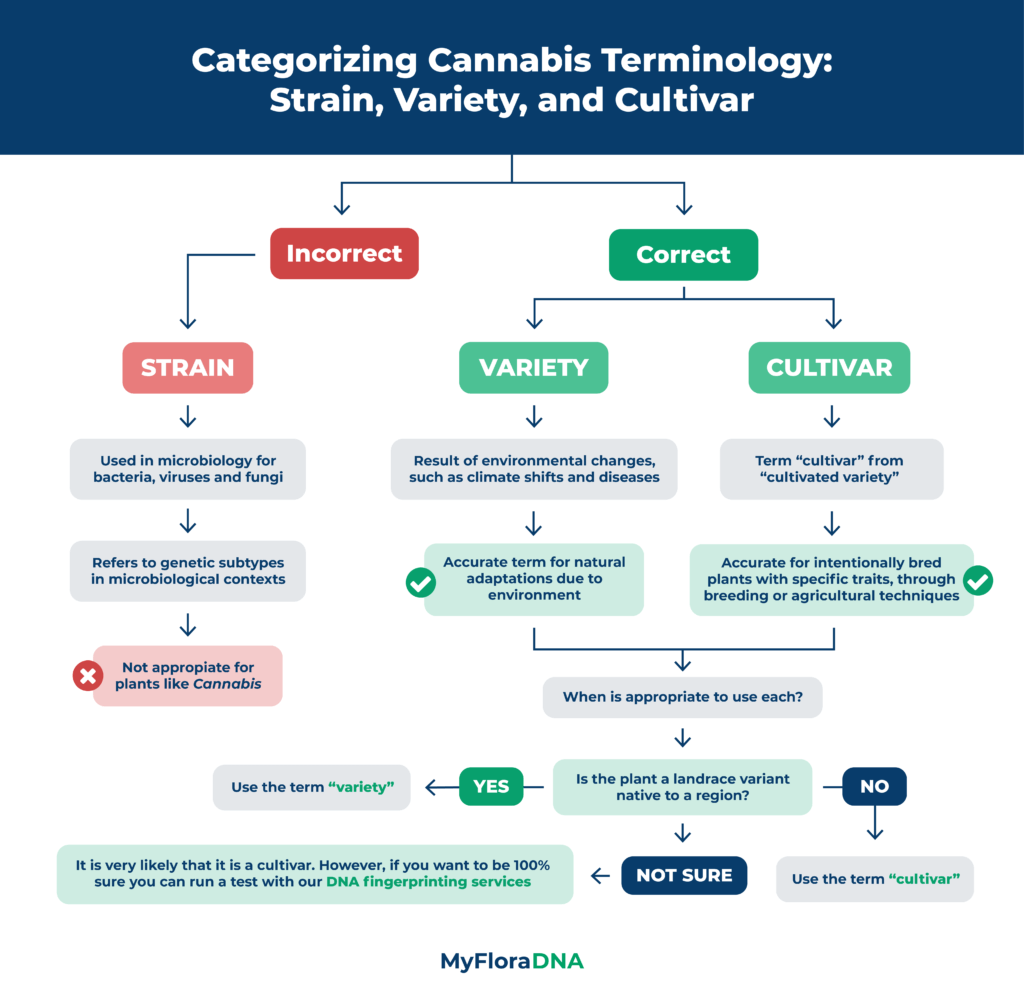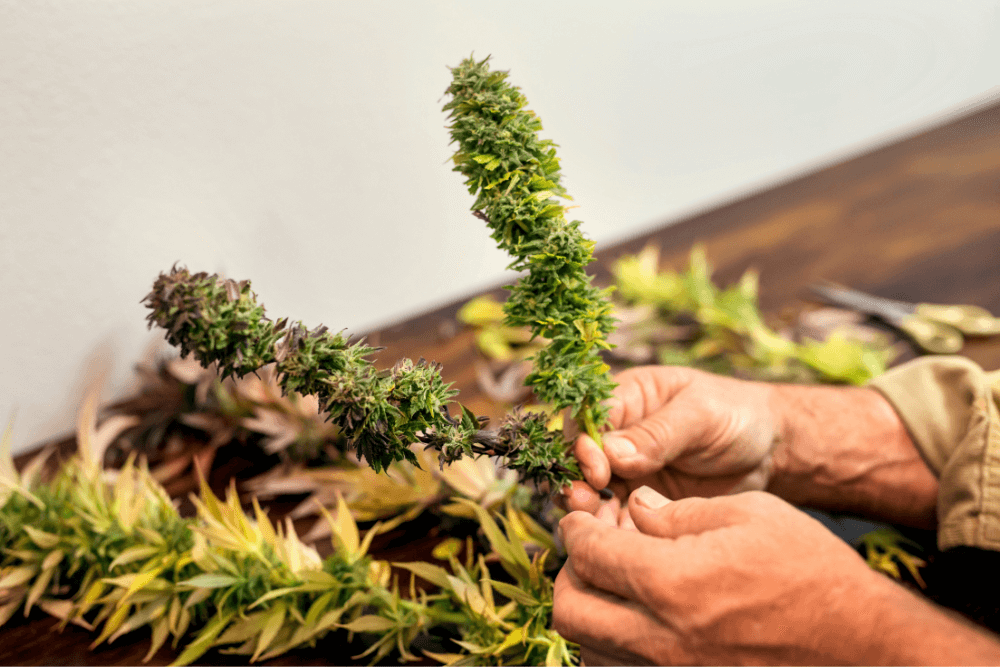In cannabis cultivation, one often comes across the terms ‘strain,’ ‘cultivar,’ and, more commonly, ‘variety’ to describe the multiple variants of this versatile plant. While these terms are sometimes used interchangeably, it is crucial to acknowledge that each carries a unique significance. Accurate communication is truly important in this dynamic field, and gaining a comprehensive understanding of these differences is essential. In this article, we embark on a journey to unravel the dissimilarities among strain, cultivar, and variety in cannabis cultivation, shedding light on the nuances that shape this captivating community.
 Strain
Strain
Commonly used in the cannabis community, the term “strain” is not entirely accurate when referring to variants of the Cannabis species. In scientific contexts, “strain” is primarily used in microbiology to discuss bacteria, viruses, and fungi (Russo, 2019). For example, in bacteriology, a “strain” refers to a specific genetic variant or subtype within a bacterial species. Each strain may have unique genetic characteristics, such as the presence of specific genes (Dijkshoorn et al, 2000).
However, when it comes to plants like Cannabis and plants in general, the use of the term “strain” is not appropriate, as it is a word reserved for the realm of microbiology. Therefore, we should avoid using it when referring to different variants of Cannabis species.
Variety
The term “variety,” on the other hand, provides a more accurate and appropriate way to describe different cannabis variants. The term “variety” is defined as a species’ adaptation resulting from changes in its habitat due to accidental factors such as climate shifts, soil changes, the presence of diseases, insect attacks, nematodes, and other similar influences (Arévalo et al., 2006). Therefore, when discussing different types of cannabis, “variety” is the most accurate term to use.
Cultivar
To avoid confusion with the botanical term “variety,” the term “cultivar” was coined. It is a combination of “cultivated variety,” shortened to “cultivar” (Arévalo et al, 2006). Unlike varieties, cultivars are not products of natural evolutionary processes. Instead, they are created through deliberate breeding or agricultural techniques to have improved and uniform traits (Tooker et al, 2012). This distinction is crucial, as it highlights the human intervention involved in developing specific plant traits and characteristics.

But, how important is it to distinguish between cultivar and variety in Cannabis? In the context of Cannabis, differentiating between cultivars and varieties is essential. Varieties refer to naturally occurring adaptations of the plant due to environmental factors, while cultivars encompass those that have been intentionally bred and developed by humans. For example, a landrace variant found growing naturally in its native region would be considered a variety, whereas a hybrid variant carefully created through crossbreeding different varieties would be classified as a cultivar.
Finally, why should we care about using the correct terminology? Understanding the distinctions between “strain,” “variety,” and “cultivar” is more than just semantic pedantry; it has practical implications for various stakeholders:
- Scientific accuracy → Employing correct terminology helps maintain scientific integrity and clear communication among researchers, botanists, growers, nurseries, and enthusiasts. All must adhere to precise terminology to communicate effectively, exchange knowledge, and avoid misunderstandings.
- Consistency → Consistent use of the terms “variety” and “cultivar” promotes a unified understanding within the cannabis community and the broader horticultural and botanical fields. Standardizing the usage of these terms will aid in streamlining scientific research, regulatory practices, and consumer education within the cannabis industry.
- Preservation of biodiversity → Understanding and distinguishing between natural varieties and cultivated cultivars contribute to the preservation of Cannabis biodiversity.
In summary, although the terms “strain,” “cultivar,” and “variety” are frequently used interchangeably in the cannabis community, they hold distinct meanings. Recognizing the proper usage of each term is essential to enhance clarity and ensure accurate communication. By understanding the differences between these terms, we can better appreciate the diverse and captivating world of cannabis, as well as the diligent efforts invested in developing unique and desirable cultivars.
References
Arévalo, R. A., Bertoncini, E. I., Guirado, N., & Chaila S.. “Los términos cultivar o variedad de caña de azúcar (Saccharum spp.).” REVISTA CHAPINGO SERIE HORTICULTURA, vol. 12, no. 1, 2006, pp.5-9. Redalyc, https://www.redalyc.org/articulo.oa?id=60912102
Dijkshoorn, L., B. M. Ursing, and J. B. Ursing. “Strain, clone and species: comments on three basic concepts of bacteriology.” Journal of medical microbiology 49.5, 2000, p. 397-401. https://doi.org/10.1099/0022-1317-49-5-397
Mostafaei Dehnavi, Mahboubeh, et al. “THC and CBD Fingerprinting of an Elite Cannabis Collection from Iran: Quantifying Diversity to Underpin Future Cannabis Breeding.” Plants, vol. 11, no. 1, 2022, p. 129, https://doi.org/10.3390/plants11010129
Russo, Ethan. “The Case for the Entourage Effect and Conventional Breeding of Clinical Cannabis: No “Strain,” No Gain.” Frontiers in Plant Science, vol. 9, 2019, p. 434025, https://doi.org/10.3389/fpls.2018.01969
Tooker, John, and Frank, Steven. “Genotypically Diverse Cultivar Mixtures for Insect Pest Management and Increased Crop Yields.” Journal of Applied Ecology, vol. 49, no. 5, 2012, pp. 974-985, https://doi.org/10.1111/j.1365-2664.2012.02173.x



Follow NCIA
Newsletter
Facebook
Twitter
LinkedIn
Instagram
–